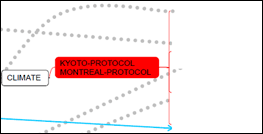
The EU's source limitation of carbon imports to the EU-ETS to Least-developed countries after 2012 has coincided with the CDM Executive Board's final rule details for PoAs and this coincidence shaped the last phase of the CDM. With appropriate additionality criteria, methodologies and projects, this phase gradually led to large emission reductions. With sufficient experimentation by investors, the energy ladder in particular household classes can be addressed in carbon regulations. I have outlined the household characteristics in Brazilian Favelas as elements of PoA designs. Programmatic CDM attain long sought sustainable development and technology transfer impacts. Principle-agent relations are an important aspect of PoA because these comprise a 'principle' offering appliances and mass users as 'agents', thereby creating split incentives and information asymmetries. Among the first 50 PoAs submitted for validation, I suggest salient country differences reflecting principle-agent relations as much as natural endowments. Important PoA elements evolve via contractual arrangements for CPA and methodology adaptations aligning incentives. Especially for stoves, the monitoring will be more differentiated to household classes and their behaviour, thereby raising quality and impact. The global PoA landscape at the end of 2012 reveals patterns among investor types. Each one brings its lessons-to-be-learned. The following two excerpts describe this landscape and parameters in investor choices: PoA Landscape by January 2013
Art.6.2 Policy and PoA Strategy The continuing dynamic among new PoA in 2020 is in Asia and Latin America driven by new carbon business models and new CME entities. Whereas African PoA are dominated by established carbon accumulators. Art.6.2 might have been intended to create new climate policy space but the Art.6.2 pilots are being built on PoA designs. PoA designers have been quite risk averse and opted to hide socio-economic conditions, for instance by not distinguishing prices charged for stoves or PV lamps. ITMO buyers might have biases to PoA business models that reflect national climate sensitivities and these ITMO buyers can seek outside the smallish PoA design habits. CDM rules are ineffective on the natural science and engineering sides, but on the other hand allow a normative ambition - representation of the global public good in negotiations. The global public good 'Certified Emission Reduction' (1 CER = 1 ton CO
Brazil - India - China institutional context
These differences help to design capacity building instruments effective in the CDM context in each country. The best empirical analysis of CDM project distribution shows that cost differences cannot explain the patterns in these three countries, "Even for the three individual countries that we examined, investments were not concentrated in projects with the lowest unit costs" (Rahman, Larson, Dinar, 2012: 24). The same data shows that within each country over time costs increase, so some economic incentives are at work.
National policies' impacts on Art.6.2
The UNFCCC is the source of normative value for the carbon markets but has little geo-political capacity. The relation between the UNFCCC and the G20 is not clear and could evolve into one between a slowly evolving rulebook that creates more and more commons and global bargaining for their distribution. However, if the bargaining requires excessive re-writing of the rulebook it can thus become a labyrinth (external sovereignty of governments could originate from both sides of that relation (Reinicke, 1998). Art.6.2 buyer countries have political histories of dealing with commons. For example the Netherlands managing tides (Rijkswaterstaat) or Japan managing space and thus find mitigation approaches more convincing that others.